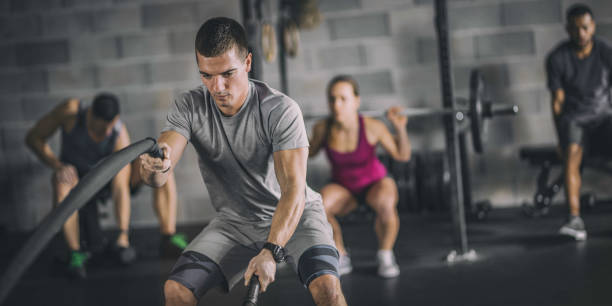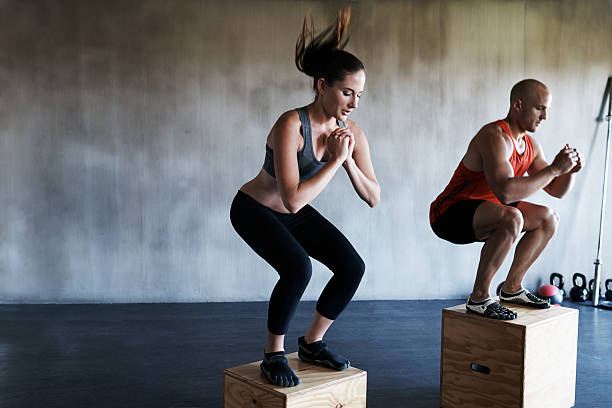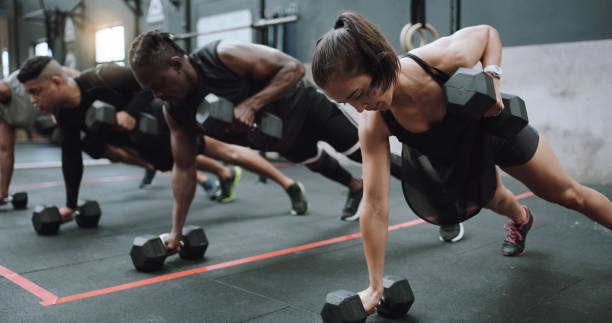Workouts
What Are The Benefits Of Functional Fitness
Functional fitness has gained popularity in recent years, and with good cause. This style of workout emphasizes everyday actions including bending, lifting, and twisting. Incorporating functional fitness into our workout routines can benefit our general health and well-being in a variety of ways.
One of the primary advantages of functional fitness is that it increases our strength and flexibility. Exercises that imitate common movements can help us target specific muscle groups and increase our overall range of motion. This allows us to complete everyday duties more effortlessly and with less danger of damage. In addition, functional fitness can help us maintain a healthy weight by burning calories and increasing our metabolism.
Another advantage of functional fitness is that it enhances our balance and coordination. This is especially crucial as we age, as falls are a significant risk factor for older persons. By including workouts that test our balance and coordination, we can increase our ability to do daily tasks safely and confidently. Overall, functional fitness is a useful and practical strategy to improve our health and well-being.

Fundamentals of Functional Fitness
Functional fitness is a style of exercise that emphasizes actions that are similar to those used in daily life. This sort of exercise is beneficial to people of various fitness levels, ages, and exercise experience. In this section, we’ll go over the fundamental ideas and exercises of operable fitness, as well as the significance of knowing movement patterns.
Key Principles and Exercises
The main elements of functional fitness are multi-joint motions, balance and stability, and a focus on functional movements. Multi-joint motions use more than one joint to complete an exercise, which can assist increase total strength and flexibility. Balance and stability exercises can assist improve posture and coordination while lowering the chance of injury. Focusing on functional movements can assist boost overall fitness and make daily tasks easier.
Lunges, squats, pushing, pulling, and bending are among the most popular functional fitness activities. These exercises can help you build overall strength, flexibility, and balance. Furthermore, operable fitness exercises such as jogging and walking can help enhance cardiovascular health.
Understanding Movement Patterns
Understanding movement patterns is a key component of operable fitness. Movement patterns describe how our bodies move throughout regular tasks including walking, jogging, and lifting stuff. Understanding movement patterns allows us to identify areas of weakness and work toward improving overall fitness.
Functional movement entails using many muscle units to complete a movement pattern. For example, a squat requires the use of the legs, core, and back muscles. We may increase our overall strength and flexibility by including functional movement exercises into our workouts, making daily chores easier.
Finally, functional fitness is a style of exercise that emphasizes actions that are similar to those used in everyday life. By adding multi-joint movements, balance and stability exercises, and a focus on functional movements, we may enhance overall fitness and make daily chores easier. Understanding movement patterns can also help us discover areas of weakness and enhance our overall fitness.

Health and Performance Benefits
Functional fitness improves our health, daily activities, and quality of life. Here are some of the main benefits:
Enhanced Daily Living
Functional fitness workouts are intended to help us move more efficiently in our daily lives. We can increase our capacity to accomplish daily activities like squatting, bending, and lifting by focusing on motions that imitate them. This can improve quality of life, particularly for older persons who may struggle with mobility.
Injury Prevention and Rehabilitation
Functional strength training can help you avoid injuries by increasing your balance, stability, and flexibility. By strengthening the muscles and joints that we use on a regular basis, we can lower our risk of injury and enhance our ability to recover from injuries. Furthermore, operable fitness can be employed as part of a rehabilitation program to assist people in regaining strength and mobility following an injury or surgery.
Improved Athletic Performance
Functional fitness can also boost athletic performance by increasing strength, power, and endurance. By combining workouts that replicate the movements of our sport or activity, we can increase our overall performance while lowering our chance of injury. To increase agility and speed on the court, a basketball player may use exercises that focus on jumping, cutting, and lateral movements.
In conclusion, functional fitness has several benefits for our health and performance. Functional workouts can help us live better lives, prevent injuries, and improve our sports ability.

Functional Fitness Techniques
Functional fitness is a style of exercise that emphasizes actions that are similar to those used in daily life. It is intended to increase general fitness and assist people accomplish daily duties with ease and efficiency. In this section, we will go over some tips for incorporating operable fitness into your workout program.
Incorporating Various Equipment
Functional fitness can be done using weights, dumbbells, machines, resistance bands, kettlebells, and free weights. Each form of equipment provides distinct advantages and can be utilized to target specific muscle groups.
Weights and dumbbells are excellent for strength training and can be used to perform a wide range of exercises including squats, lunges, and deadlifts. Machines can also be used for strength training, and they are frequently intended to target particular muscle groups.
Resistance bands and kettlebells are excellent for endurance training and may be used for a number of workouts including rows, pushes, and swings. Free weights, such as medicine balls, can also help with endurance and coordination.
Designing a Functional Fitness Routine
When developing a functional fitness program, it is critical to prioritize workouts that enhance form, balance, stability, core stability, mobility, flexibility, coordination, strength training, and endurance. A well-rounded workout should include exercises that target various muscle groups and motions.
Bodyweight exercises like push-ups, squats, and lunges are excellent for developing form, balance, stability, and core strength. They can also help to improve strength and endurance.
Incorporating mobility and flexibility activities, such as yoga and stretching, can enhance range of motion and lower the risk of injury.
Coordination can be improved by including balancing exercises like single-leg deadlifts and standing on one foot.
Weightlifting, resistance band training, and bodyweight workouts are all ways to build strength.
Running, cycling, and rowing are all exercises that boost heart rate and respiration, which can help with endurance.
To summarize, functional fitness is an excellent technique to increase overall fitness and assist people do daily chores with ease and efficiency. Individuals can enhance their form, balance, stability, core stability, mobility, flexibility, coordination, strength training, and endurance by incorporating different equipment and creating a well-rounded routine.

Tailoring Functional Fitness to Individual Needs
Functional fitness is a dynamic training program that can be customized to meet the demands of people of various fitness levels and goals. Here are some pointers on how to tailor functional fitness to specific requirements.
Adapting for Different Fitness Levels
Functional fitness routines can be modified to accommodate a variety of fitness levels, from beginners to advanced athletes. Beginners should start with bodyweight exercises including bodyweight squats, walking lunges, and planks. Before moving on to more advanced movements, these exercises help to establish a strong and mobile foundation.
Functional training can help intermediate and advanced athletes enhance their speed, power, and conditioning. This can be accomplished by workouts like deadlifts, overhead presses, and high-intensity functional training (HIIT). Individuals can push their body and enhance their overall fitness by increasing the intensity and diversity of exercises they perform.
Functional Fitness for Specific Populations
Functional fitness can also be tailored to the needs of certain groups, including elders, pregnant women, and people with impairments. Functional exercise can help seniors improve their balance, mobility, and quality of life. Exercises including lunging, squatting, and overhead pressing can help improve functional movements and lower the chance of falling.
Functional fitness can assist pregnant women maintain a healthy weight, lower their risk of gestational diabetes, and increase overall fitness. Low-impact activities like yoga and bodyweight workouts might be useful during pregnancy.
Functional fitness can help people with impairments gain strength, mobility, and general fitness. Exercises can be modified to meet the individual’s demands and abilities, such as employing resistance bands or changing movements.
Overall, functional fitness is a quick and efficient technique to boost overall fitness and achieve personal goals. Individuals who personalize functional fitness to their own demands can obtain optimal outcomes and improve their overall quality of life.
Conclusion
The emphasis on core strength and stability in operable fitness has far-reaching implications for health and well-being. A robust core not only enhances posture and reduces the risk of injuries but also positively influences various physiological functions. The benefits extend beyond the physical realm, with functional fitness contributing to improved balance, coordination, and even cognitive function.
In the realm of preventive health, operable fitness stands as a stalwart guardian. Its capacity to enhance proprioception and spatial awareness, coupled with the promotion of joint health, serves as a preemptive strike against injuries. This preventive aspect aligns with a proactive approach to well-being, empowering individuals to take charge of their health before issues arise.
As a transformative force in the fitness landscape, functional fitness offers a dynamic and engaging alternative to traditional exercise routines. The practical benefits, adaptability, and holistic impact on overall health position operable fitness as a valuable addition to any wellness journey. Whether you’re striving for improved functionality in daily activities, seeking a well-rounded fitness regimen, or simply embracing a healthier lifestyle, operable fitness emerges as a versatile and empowering ally. In conclusion, my exploration into the benefits of operable fitness has affirmed its significance as a comprehensive and practical approach that extends beyond the confines of conventional workouts. It’s not just about how we look but, more importantly, about how we move, feel, and thrive in our daily lives.
Journey of self discovery


